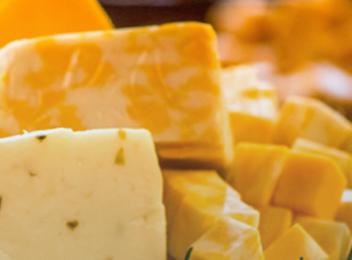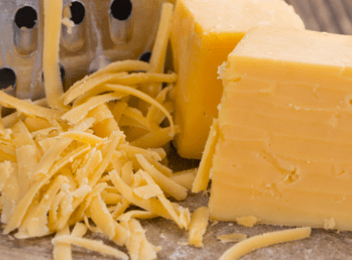Currently, there is no formal definition of ‘natural cheese’. In the cheese industry, the term “natural” is used to differentiate between “standard” cheese and processed cheese. All of Glanbia Nutritionals’ cheese varieties are considered natural cheese.

Navigating Natural: Cheese
An in-depth review of natural claims and how they relate to dairy.
When it comes to the world of natural claims, particularly as they relate to dairy, the path is often hard to follow. With two sides to every story, it’s easy to get lost in the debate losing sight of the claims’ original intent. It is our hope that we can help you navigate what each of these claims truly mean as they relate to farm practices, dairy cows and cheese manufacturing. As partners in the supply chain of cheese production we will continue to provide the most up-to-date information pertaining to industry regulations. When it comes to navigating natural claims, Glanbia Nutritionals is here to help.
Natural
Key Takeaways

The term “natural” in the food industry has been under increased scrutiny as consumers struggle to understand an array of label claims. The Food and Drug Administration (FDA) has a longstanding informal policy, established through statements in 1991 and 1993 that act as guidelines but not a formal definition. The informal policy from the FDA defines “natural“ as: “nothing artificial or synthetic (including colors regardless of source) is included in, or has been added to, the product that would not normally be expected to be there.“ “Natural cheese” is an established industry term used to distinguish non-processed cheese from processed cheese. Natural cheese is made from milk, cheese cultures, enzymes (rennet) and salts versus processed cheese which is made by heating natural cheese and combining other ingredients like preservatives.
Glanbia Nutritionals’ Approach

While the definition of natural in food (including the long standing use in cheese), is under review, Glanbia Nutritionals continues to produce cheese in compliance to the Code of Federal Regulations (CFR). Managed by the FDA, CFR section 133 are the guidelines for cheese and cheese related product production. When it comes to recognized natural cheeses such as Cheddar and Colby Jack, each variety has federal requirements in regards to physical and chemical properties such as milk fat and moisture ranges. These ensure a standard of identity for each variety is preserved.
Who is the Natural Cheese Consumer?
Download the Natural Cheese Consumer Research PDF
For more information on our Navigating Natural consumer research study
Organic
The United States Department of Agriculture (USDA) Certified Organic program has strict guidelines pertaining to organic milk production. Glanbia Nutritionals’ organic dairy partners adhere to USDA guidelines. To assure compliance, the National Organic Program (NOP) monitors certified organic dairies through approved agents.
Key Takeaways

Dairy farmers who produce certified–organic milk must go through a rigorous process to become organically certified through the U.S. Department of Agriculture (USDA). Under USDA standards, dairy farmers must be in compliance with the following:
- Feed: The 100% organic feed ration can include forages from land being managed organically and is certifiable.
- Healthcare Practices: Animals must be kept in healthy, low stress environments. Producers must use preventative health care practices and may only use approved treatments.
- Land Requirements: Land used for pasturing, housing livestock and livestock feed, and bedding must be certified organic. Farmers may transition non-organic farm land to organic over a three year process in which the farmer must manage the land according to organic standards.
- Living Conditions: Livestock housing must provide for adequate ventilation, supply of clean water and proper sanitation. Housing must provide access to the outdoors, shade, shelter, exercise areas, fresh air and direct sunlight year round. Continuous total confinement of any ruminant animal over six months of age indoors is prohibited.
- Marketing & Labeling: Agricultural products in packages that are to be sold, labeled or represented as “100% organic“ or “organic“ may display on the package panel or any marketing/ labeling information about the product the following: The term “100% organic“ or “organic", as applicable to modify the name of the product. The USDA seal and the certifier’s logo/seal.
- Origin of Livestock: Farmers may either transition an existing non-organic herd to organic production or purchase an organic herd. The transition is a one year process, during which the producer must manage the herd following the organic standards.
- Record Keeping: Records must be kept on an ongoing basis. Records are essential, as organic certification is about verifying farming practices to a third party. Records must be “readily auditable“ (accessible, organized, complete) and must be maintained for five years. In general, the record keeping system must allow a third party to trace management from birth/purchase to death/sales. Many certifiers provide record keeping templates but also accept farm-specific systems, so long as they include the necessary information.
For additional information on the National Organic Program, please refer to the USDA’s website at www.usda.gov/organic-agriculture.html
Glanbia Nutritionals’ Approach

All organic milk is kept separate from conventional (non- organic) milk starting at the farm all the way to finished product. Glanbia Nutritionals’ offering of organic cheeses are certified USDA organic and follow all regulations outlined in 7 CFR §205. Under USDA standards, Glanbia Nutritionals must adhere to all guidelines for organic certification of dairy livestock.
The ISDA is the monitoring agency for Glanbia Nutritionals. Glanbia Nutritionals also employs experienced field staff who monitors our organic dairy partners to assure accordance year round. Glanbia Nutritionals must adhere to specific cleaning and segregation protocols to ensure integrity of the organic milk product when it is picked up and put into the cheese make process.
Who is the Organic Cheese Consumer?
Download the Organic Cheese Consumer Research PDF
For more information on our Navigating Natural consumer research study
GMO Free
Foods coming from livestock–including milk–do not require GMO labeling, even if the animal consumes feed containing GM corn as part of its diet. Glanbia Nutritionals is aligned with the industry to meet evolving consumer expectations. Glanbia Nutritionals can meet the nonGMO demand through our USDA certified organic cheese program.
Key Takeaways

Genetically modified organisms, or GMOs, refer to the result of copying a desirable gene with a desired trait from one plant or organism and using it in another plant. Fluid milk is not genetically modified nor is the cow that produces the milk; however, their balanced diet contains ingredients that may come from GMO plants e.g. soybeans, corn, canola, alfalfa.
With 90% of the corn grown in the US being genetically modified, it is difficult and more expensive to source non-GMO feed. The National Milk Producers Association (NMPA) supports farmers right to choose, sourcing evidence that GM crops are not only safe, they also provide broad environmental benefits in reducing soil loss, reducing farms’ use of water, as well as fuel.
Glanbia Nutritionals’ Approach

At Glanbia Nutritionals, we acknowledge and support technologies proven by regulatory agencies that safeguard sustainable innovation- which includes GM feed sources. We partner with the dairy industry leaders to meet evolving consumer expectations for additional transparency and sustainability in modern farming and support clarity in food labeling.
We stand with our milk suppliers in their rights to use such approved technology while maintaining diligent oversight and transparency in telling their story to the consumer. We support legislation which gives consumers information about what's in their food.
Who is the GMO Free Cheese Consumer?
Download the GMO Free Cheese Consumer Research PDF
For more information on our Navigating Natural consumer research study
Antibiotic Free
All of Glanbia Nutritionals’ milk, and by natural extension cheese, is antibiotic free. In compliance with the USDA, rigorous testing throughout the milk cycle is done to ensure milk is free from antibiotics. Glanbia Nutrionals’ USDA Certified Organic milk is “from cows not treated with antibiotics.”
Key Takeaways

There are two common claims when it comes to antibiotic use. The first is “made from antibiotic free milk” or more simply “antibiotic free. “The second claim goes a step further and states “from cows not treated with antibiotics.”
- Antibiotic Free: Milk used in cheese making is always “antibiotic free“. In accordance to the FDA requirements, all milk is tested for common antibiotics used to treat dairy cows down to the parts per million.
- From Cows Not Treated with Antibiotics: This claim maintains that cows being milked on the farm will not be treated with antibiotics. That said, if an animal is sick a farmer still maintains the right to treat the animal with antibiotics and then transition the animal to a conventional farm forever. Organic dairies, in order to become USDA certified, cannot use antibiotics to treat their cows, therefore organic cheese is “from cows not treated with antibiotics".
Glanbia Nutritionals’ Approach

- Antibiotic Free: Specific steps are taken to ensure our milk is antibiotic free. Our dairy partners use antibiotics responsibly and carefully to treat their cows. On the farm, a cow treated with antibiotics is marked and isolated from the milking herd during treatment. This is to ensure the animal can be treated as well have their milk properly segregated from the milk being shipped. Each farm’s milk is sampled individually and then again upon arrival to the Glanbia Nutritionals facility before it is unloaded into the plant silos. In the event that a load tests positive for antibiotics (which is rare), Glanbia Nutritionals would run a producer sample to identify which farm the contamination came from. The milk is disposed of and reported to the ISDA for regulatory follow up.
- From Cows Not Treated with Antibiotics: Milk from Glanbia Nutritionals’ organic dairy partners is from cows not treated with antibiotics.
For more information on our Navigating Natural consumer research study
Artifical Hormone/rBST Free
Synthetic or artificial rBST or rBGH hormone can be used on dairy cows to increase milk production by supplementing the cows own production of Bovine Somatotrophin (BST). The FDA affirms milk from cows treated with artificial rBST or rBGH is safe. Glanbia Nutritionals can source rBST free milk – farmers sign an affidavit demonstrating full commitment but no test exists.
Key Takeaways

All milk, whether from a conventional dairy or a USDA organic certified dairy, naturally contains hormones. Some farmers choose to treat their cows with a synthetic hormone, the FDA-approved artificial rBST or rBGH, to increase a cow’s milk supply. This decision is up to each individual dairy farmer, and the benefits can include improved efficiency of the farm by allowing dairy farmers to produce more milk using fewer natural resources.
Some consumers are not comfortable with synthetic hormones being used in dairy products; however, both National and International government health officials have verified that milk from cows treated with artificial hormones is safe–a belief supported by the IDFA. rBST and rBGH have been heavily tested and researched since they came onto the market nearly twenty-five years ago.
Put simply–these studies indicate there is no difference between milk from cows treated with artificial hormones and milk from those not treated.
Glanbia Nutritionals’ Approach

Glanbia Nutritionals neither advocates nor opposes the use or approval of rBST or rBGH. Glanbia Nutritionals can source milk from cows that have not been treated with artificial hormones. There is no current industry-wide test used upon milk arrival to Glanbia Nutritionals facilities, rather each farmer signs an affidavit demonstrating full commitment to keeping their herd free from any artificial hormone treatment.
Who is the rBST Free Consumer?
Download the rBST Free Cheese Consumer Research PDF
For more information on our Navigating Natural consumer research study
Grass Fed Vs Pasture Fed
The statement “grass fed cows" relates more directly to what percentage grass is in a cow’s diet versus “pasture fed cows" which relates more to the access a cow has to graze. Glanbia Nutritionals’ can source milk from cheese from both Grass Fed (from Ireland) and Pasture Fed (from Organic dairies.)
Key Takeaways

First, we need to define the difference between “milk from grass fed cows“ and “milk from pasture fed cows“ in regards to dairy products. A simple way to look at it would be to say that “grass fed“ tends to focus on what the cow is eating where “pasture fed“ focuses more on where the cow is eating.
- Grass Fed: Currently, the grass fed dairy systems inside the US do not have federal definitions or regulations in place for grass fed claims in regards to dairy products. As a result, the market has developed a range of different interpretations on labels, some stemming from the USDA beef definition but most generated by industry standards. Grass fed claims traditionally reference how much grass makes up a cow’s total diet (for example, a standard may state that a grass fed cow’s nutritional feed must be made up of 90% grass).
- Pasture Fed: By comparison, “milk from pasture fed cows“ makes the distinction that cows have access to pasture a certain number of days per year, but does not always define the amount of grass, as a percentage or otherwise, that makes up a cow’s diet. The USDA Organic program requires “cows be provided pasture throughout the entire grazing season for the geographical region, which shall not be less than 120 days per calendar year“ which therefore qualifies as “milk from pasture fed cows".
Glanbia Nutritionals’ Approach

Grass Fed: In light of having no US definition, Glanbia Nutritionals is aligning with the Irish dairying system in delivering an authentic grass fed cheese to our customers. Under the Irish Dairy Grassfed system, dairy farmers must demonstrate, among other things, the following processes:
- Cows are grazed on grass lands for up to 270 days a year with the remainder housed for animal welfare purposes but continuing on a grass silage diet with some limited supplementation, including grains.
- Irish dairy cows receive 93% of the nutritional feed from grass.
Pasture Fed: Glanbia Nutritionals does have access to milk from pasture fed cows. By definition, USDA Organic certified milk can be called out as “milk from pasture fed cows.” Non-organic, pasture access milk is limited in the US given the current feed, range access and rations. If this claim is of interest to you, please work with your Glanbia Nutritionals representative.
Who is our Grass Fed/Pasture Fed Cheese Consumer?
Download the Grass Fed/Pasture Fed Cheese Consumer Research PDF
For more information on our Navigating Natural consumer research study
No Artifical Flavors or Colors
Annatto or Beta Carotene is commonly used to color cheese. The IDFA is petitioning that the natural claim remain in commercial use as long as the ingredients (annatto or beta carotene) are derived from natural sources. All of Glanbia Nutritionals’ added flavors or colors are derived from natural sources.
Key Takeaways

Color: Annatto extract and beta carotene are considered by the FDA as non-certified colors. Non-certified colors still need to be labeled in the ingredient statement but different options may be used such as “artificially colored,“ “artificial color,“ “artificial color added,“ “color added,“ “colored with ____ “ or “____ (color).“
Despite the fact that color additives, such as annatto extract, may be derived from a natural source it does not naturally occur in cheese. Therefore, it needs to be declared as “artificial color“. The FDA has indicated the use of the term “natural color“ or using the term “natural“ may be misinterpreted to mean the color was naturally occurring in the food.
In May 2016, the International Dairy Foods Association (IDFA) advocated the FDA to assess “whether an ingredient is “natural“ by the source of the ingredient (i.e. is it natural or artificial) rather than function nor being a raw ingredient. These criteria should be applied to colors, flavors and other ingredients.“
Flavor: Most of the flavor in cheese comes from the milk used, the cultures and the aging process. This flavor is all attained naturally and continues to get stronger over time. Flavors can also be added to cheese, such as peppers, smoke or seasonings. Most of these are derived from natural ingredients but artificial flavors can also be added to cheese to attain certain flavors. The IDFA “strongly encourages“ the FDA to establish a regulatory definition for natural, believing it will continue to eliminate consumer confusion and position dairy in a positive light. The IDFA challenged the FDA that by labeling natural to single ingredient foods would be “arbitrary and unreasonable“.
Glanbia Nutritionals’ Approach

Glanbia currently uses no color on white cheese varieties and annatto or beta-carotene on colored cheese products. Any flavor, unless specified otherwise, will be derived from natural sources.
Who is the Artificial Flavor & Color Free Cheese Consumer?
Download the Artificial Flavor & Color Free Cheese Consumer Research PDF
For more information on our Navigating Natural consumer research study







